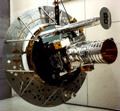COSPAR ID 1981-100A Mission duration ~7 years Inclination 97.5589° Period 1.6 hours Rocket Delta 2000 | SATCAT no. 12887 Launch date 6 October 1981 Inclination 97.5589° Launch mass 437 kg | |
 | ||
Similar Student nitric oxid, Solrad 8, Explorer 11, CHIPSat, Explorer 7 | ||
Gary rottman the vision development and success of the solar mesosphere explorer
The Solar Mesosphere Explorer (also known as Explorer 64) was a United States unmanned spacecraft to investigate the processes that create and destroy ozone in Earth's upper atmosphere. The mesosphere is a layer of the atmosphere extending from the top of the stratosphere to an altitude of about 80 kilometers (50 mi). The spacecraft carried five instruments to measure ozone, water vapor and incoming solar radiation.
Contents
- Gary rottman the vision development and success of the solar mesosphere explorer
- James stuart my experience with charlie barth and his solar mesosphere explorer project
- References
Launched on October 6, 1981, on a Delta rocket from Vandenberg Air Force Base, in California, the satellite returned data until April 4, 1989. The spacecraft reentered Earth's atmosphere on March 5, 1991.
Managed for NASA by the Jet Propulsion Laboratory, the Solar Mesosphere Explorer was built by Ball Space Systems and operated by the Laboratory for Atmospheric and Space Physics of the University of Colorado where one hundred undergraduate and graduate students were involved.
